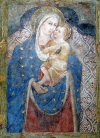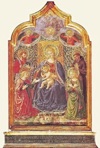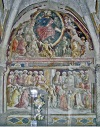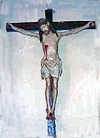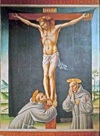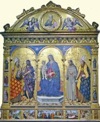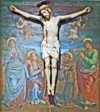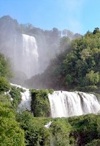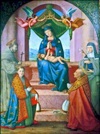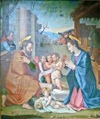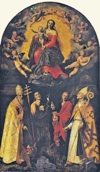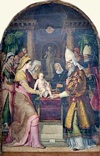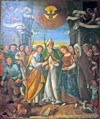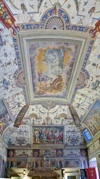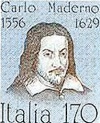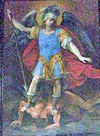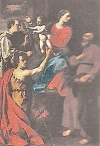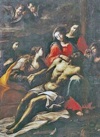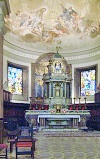

Maestro della Dormitio di Terni (ca. 1400)
Probably from Terni
Maestro di Narni del 1409
This master is named for a panel of the Madonna and Child enthroned that is dated by inscription to 1409. This panel, which is now in the Musée du Petit Palais, Avignon, seems to have been the central panel of a polyptych in Sant’ Agostino, Narni. Most of the surviving frescoes that are attributed to this master and his workshop are in Narni. Works in Terni that are attributed to him include:
-
✴a fresco of the Madonna and Child with SS John the Baptist and Catherine of Alexandria in San Pietro (illustrated here), and
-
✴(less securely), a fresco in Santa Maria del Monumento.
Bartolomeo da Miranda (died after 1449)
This fresco, which is now on the back wall of the deconsecrated church of San Marco, is one of the finest of the works attributed to Bartolomeo da Miranda.
Benozzo Gozzoli (1420-97)
This small and beautifully detailed panel (1466) of the mystic marriage of St Catherine is signed by Benozzo Gozzoli and dated by inscription. It came from Santa Maria dell' Oro and is now in the Pinacoteca Comunale.
Bartolomeo di Tommaso (ca. 1408-54)
The important fresco cycle (ca. 1449) of scenes from the Last Judgement in Cappella Paradisi, San Francesco is attributed to Bartolomeo di Tommaso.
Giovanni Tedesco (late 15th century)
A document of 1491 reveals that Giovanni Tedesco was then living in Terni, and that the Commune gave him a pigeon house in return for a Crucifix (now lost) that he made for the chapel of the Palazzo dei Priori. Three other Crucifixes (late 15th century) in Terni are attributed to Giovanni Tedesco:
-
✴two in the Pinacoteca Comunale:
-
•one from a Franciscan location (perhaps the Capuchins’ San Martino or the Observant Franciscans’ Santa Maria delle Grazie); and
-
•one that is certainly from Santa Maria delle Grazie; and
-
✴one that is still in Santa Maria dell’ Oro (illustrated here).
Nicolò di Liberatore, l' Alunno (1430-1502)
Nicolò di Liberatore was perhaps the most important participant in the vibrant artistic milieu of Foligno in the 15th century. This gonfalon (1497) of the Crucifixion with SS Francis and Bernardino of Siena is signed by Nicolò di Liberatore and dated. It probably came from the Observant Franciscan church of Santa Maria delle Grazie, and is now in the Pinacoteca Comunale.
Pier Matteo d' Amelia (ca. 1445-1509)
The important Pala dei Francescani (1483-5), which is a documented work that Pier Matteo d’ Amelia painted for the church of San Francesco, is now in the Pinacoteca Comunale.
Giovanni di Pietro, lo Spagna (died 1528)
This frescoed backdrop (16th century) to a Crucifix, which is attributed to Lo Spagna, came from from Santa Maria delle Grazie and is now in the Pinacoteca Comunale.
Antonio da Sangallo il Giovane (1484-1546)
Antonio da Sangallo il Giovane was one of the leading architects in Rome, particularly after the election of Pope Paul III in 1534. He died in Terni while undertaking hydraulic work for Pope Paul III at the Cascata della Marmore. The designs of two palaces in Terni are somewhat unreliably attributed to him:
-
✴Palazzo Rosci (16th century); and
-
✴Palazzo Spada (1555-75).
Pompeo Cocchi (died after 1552)
This altarpiece (16th century) of the Madonna and Child with saints, which almost certainly came from the Franciscan nunnery of San Procolo, is attributed to Pompeo Cocchi. It is now in the Pinacoteca Comunale.
Domenico Alfani (died after 1553)
Domenico Alfani came from a noble family and was a close associate of Raphael in the early 16th century. Two altarpieces from Santa Maria delle Grazie that are now in the Pinacoteca Comunale are attributed to to Domenico Alfani or to his workshop. They include this panel of the Nativity.
Johann Marten Stellaert (died after 1568) and Gillis Congnet (died 1599)
These Flemish artists were documented in Terni in 1567-8.
-
✴Johann Marten Stellaert signed an altarpiece (1568) of the Madonna and Child with saints, which was probably painted for an altar in the Duomo and which is now in the Museo Diocesano; and
-
✴the frescoes (1567-8) in Palazzo Giocosi are attributed to the two artists.
Giacomo Barozzi da Vignola (1507-73)
From Vignola, near Modena, based in Rome
Vignola had a very successful career in Rome, where he often worked for the papacy. He also worked in Umbria, often as an advisor, at the behest of prominent nobles with interests there. In Terni, he designed an alternative to the wooden Ponte Sant’ Antonio.
[Temporary link to Vignola]
Livio Agresti (1508–1580)
This panel (1560) of the Circumcision of Christ is signed by Livio Agresti and dated by inscription. It came from the nunnery of Santa Monica and is now in the Museo Diocesano. [It is presently in restoration.]
Lattanzio Pagani (died ca. 1582)
Lattanzio Pagani worked mainly for Pope Paul III and for Cardinal Tiberio Crispo, who was the the papal legate in Umbria in 1545-8. He neglected his work as an artist from 1553, when he became Captain of the Militia of the provinces of Umbria and the Marche. This altarpiece (16th century) of the Marriage of the Virgin in the Pinacoteca Comunale, which came from the church of Santa Lucia, is attributed to him.
Karel van Mander (1548- 1606)
Karel van Mander, who spent only a short period in Italy, is best known as the “Dutch Vasari” because of his book on the lives of artists that was published in Amsterdam in 1604. The frescoes (1575-6) in Palazzo Spada probably include the “several large pieces” that he painted “for a count in Terni” that are mentioned by his biographer. If so, the count in question was Count Michelangelo Spada.
Carlo Maderno (1556-1629)
Carlo Maderno, who moved to Rome to work with his uncle, Domenico Fontana, became one of the leading architects of the Baroque period. His work in Umbria included work on the drainage of the Rieti Plain outside Terni in 1598.
Giuseppe Cesari, il Cavalier d’ Arpino (1568-1640)
This altarpiece (ca. 1630) by the Cavalier d’ Arpino, which depicts St Michael crushing demons, is in the Cappella di San Michele, San Valentino.
Andrea Polinori (1586-1648)
This altarpiece (1635) of the Madonna and Child with SS Lawrence, John the Baptist and Bartholomew in San Valentino is signed by Andrea Polinori and dated by inscription.
Giovanni Francesco Barbieri, il Guercino (1591-1666)
From Cento, near Bologna, based in Bologna
A panel (17th century) in the Museo Diocesano, which depicts the Resurrection of Lazarus, is attributed to the workshop of this prolific Baroque artist.
[Temporary link to Giovanni Francesco Barbieri, il Guercino]
Girolamo Troppa (died after 1710)
Works in Terni by or attributed to Girolamo Troppa include:
-
✴an altarpiece (1680) that depicts a miracle that happened when the relics of St Cassius were returned to Narni in 1679, which is now in the Museo Diocesano (attributed);
-
✴a fresco (17th century) depicting the Assumption of the Virgin in the vault of Santa Maria del Carmine (attributed);
-
✴frescoes (17th century, mostly attributed) in:
-
•Palazzo Pierfelici;
-
•Palazzo Carrara;
-
•Palazzo Montani; and
-
•Palazzo Gregori-Canale-Morelli; and
-
✴two altarpieces (17th century) in the Pinacoteca:
-
•a signed panel of the Lamentation, which is of unknown provenance (illustrated here); and
-
•a panel of the Madonna and Child with the young St John the Baptist and SS John the Evangelist and Peter of Alcantara, which was documented in San Procolo in 1726 (attributed).
Carlo Murena (1713-64)
Carlo Murena trained as an architect in Rome under Luigi Vanvitelli (below), and later looked after Vanvitelli’s practice in Rome. He designed the tabernacle (1762) for the high altar of the Duomo.
Liborio Coccetti (ca. 1739-1816)
From Foligno
Liborio Coccetti, who became one of the favoured artists of Pope Pius VII, left very little in his native Foligno. His works in Terni include the fresco (1782) of the Trinity in Glory in the apse of the Duomo.
[Temporary link to Liborio Coccetti]
Return to the home page on Terni.


